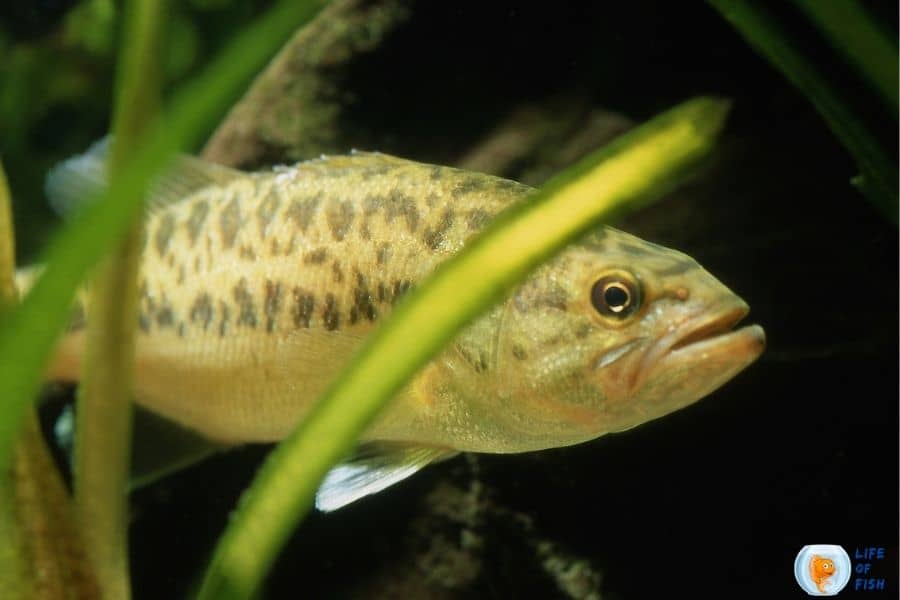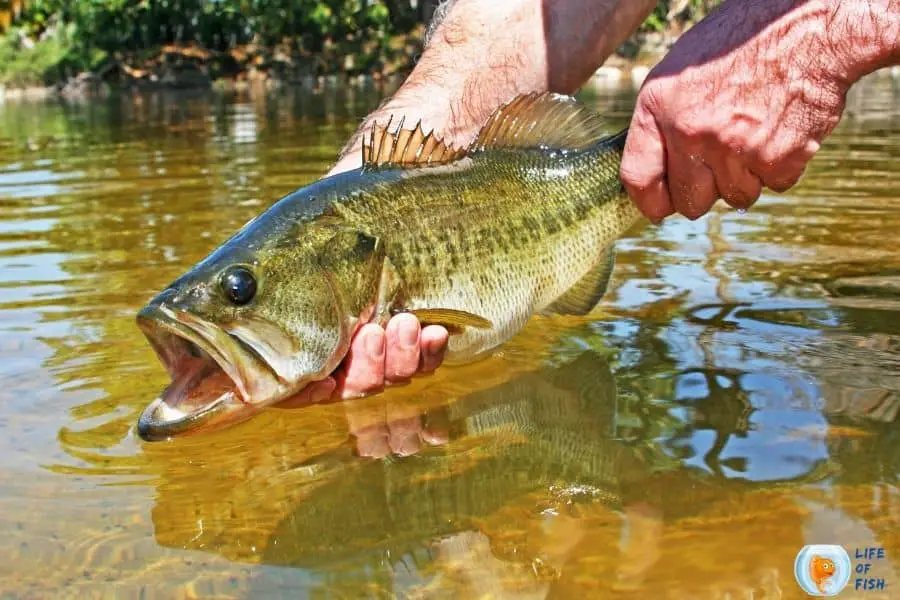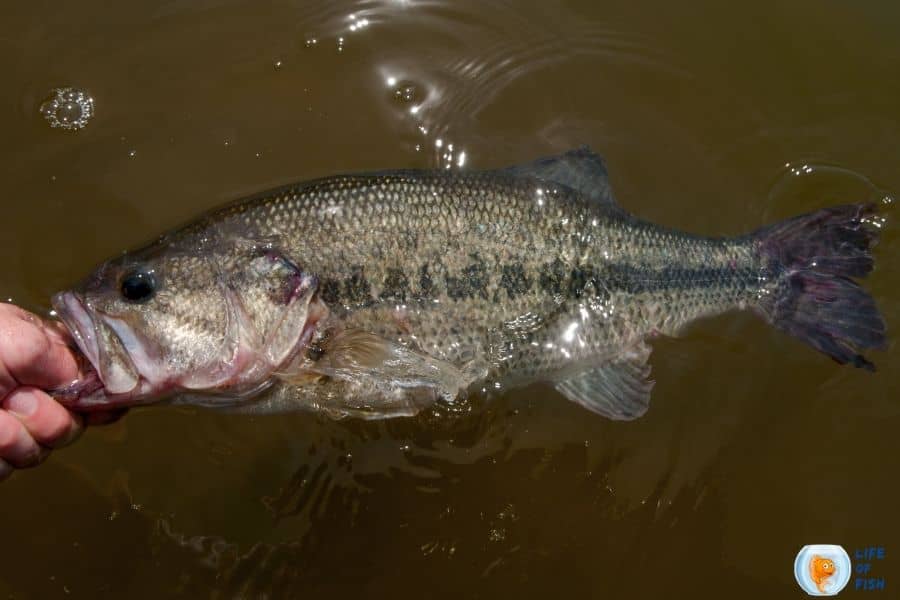Largemouth Bass habitats reside in the eastern and central United States, northern Mexico, and southeastern Canada.
But because of their sporty nature, these fish have been introduced throughout the United States, Canada, and several other countries.
In this article, we will discuss Largemouth Bass habitats, where you can find them in each season, where they spawn, and more facts.

What are they?
Jump To
- 1 What are they?
- 2 Where does the largemouth bass live?
- 3 What type of water does largemouth bass live in?
- 4 Largemouth bass water conditions
- 5 Can Bass live in a small pond?
- 6 How many largemouth basses can you have in a 1/2 acre pond?
- 7 Where does Bass live in a lake?
- 8 Where does Bass go in the summer?
- 9 Where does Largemouth bass live in the Spring?
- 10 Where does Largemouth bass live in the fall?
- 11 Where does largemouth bass go in the winter?
- 12 Where does juvenile largemouth bass live?
- 13 Largemouth bass spawning areas
- 14 Conclusion
Largemouth Bass (Micropterus salmoides) are non-migratory fish, meaning they stay put in one area.
They also have a wide habitat range, found in lakes, streams, rivers, swamps, and even reservoirs! The species is considered an ‘aggressive’ type and will eat almost anything.
Largemouth Bass can be found in both warm and cool water climates. They tend to stay in either deeper, cooler waters or in the weeds and cover cooler waters in the summer.
They prefer deeper water because it is dark and easy to hide, especially from predators.
Largemouth Bass are also found in more shallow waters in the spring and fall because of their need for warmer water.
They will spawn then, making it an ideal time for an angler to catch them. Bass eggs are very susceptible to the sun and must be kept in cover, so they find shallower, darker waters for spawning.
Where does the largemouth bass live?
Largemouth Bass, native fish populations live in clear and vegetated waters such as ponds, lakes, swamps, and rivers that are deep enough to hold fish.
They like to occupy the areas where Bass feels comfortable such as sandy bottoms or muddy bottoms.
There is generally no specific depth for largemouth, but they prefer deeper waters (8-15 ft) during daylight hours; however, the shallower waters (1-5 ft deep) at night.
The largemouth bass prefers waters with a slow current when it is available.
What type of water does largemouth bass live in?
You can find Largemouth bass in freshwater habitats as well as brackish water habitats. They prefer clear waters despite the water’s salinity level.
However, they are primarily found in freshwater habitats such as ponds, lakes, and rivers.
Largemouth bass water conditions
Generally, Largemouth Bass prefer clear shallow water habitats with slow to no water current. They can tolerate some salinity.
Hence this freshwater fish can also live in brackish waters. The habitat should be planted, but they do not prefer densely vegetated areas either.
Prefered water conditions for Largemouth Bass are:
- Dissolved Oxygen- > 8.0 mg/l
- Water temperatures- 24 – 30 C
- pH- 6.5 – 8.5
- Turbidity(cloudiness)- 5-25 ppm
- Water Current- < 6 cm/sec
Since many water habitats meet these water conditions, these fish are distributed widely. However, they are less tolerant of poor water quality than other fishes.

Can Bass live in a small pond?
Yes. Largemouth Bass can live in ponds as long as less than five basses are living in the pond. If stocked more than five fish, it will make the fish more vulnerable and stressed.
Small ponds may not meet other water conditions such as dissolved oxygen, temperature, and pH. So, keep these facts in mind if you plan to keep these fish in your pond and make necessary changes.
How many largemouth basses can you have in a 1/2 acre pond?
You can have about 30 5 to 7 inches largemouth Basses in your 1/2 acre pond.
If your pond is already stocked with other fishes, you should store less than 30 fish to provide sufficient space for all fishes.
If your pond is already stocked with large predatory fish, you will have to catch them first before introducing your Bass to the pond. Otherwise, your Bass will be prey for the larger fishes.
Where does Bass live in a lake?
Largemouth bass usually lives in shallower bays of lakes close to submerged aquatic vegetations such as water lilies and pondweed.
You can also find them near sunken logs as well as muddy bottoms. During the daytime, these fish goes to the bottom of the water where it is safe.
During the nighttime, they come near the surface to feed.
Where does Bass go in the summer?
In the summer, the water temperature rises. Largemouth Bass can not tolerate hot temperatures.
Therefore, these fish usually goes to densely vegetated areas to take cover. They also move out to the middle of their habitat, where it is deep enough to hold cooler water.
In the summer, Bass prefers to remain slightly above the thermocline.
Where does Largemouth bass live in the Spring?
Largemouth Basses spawn in the Spring when their conditions are met. Until they meet the ideal water conditions, these fish live in transition points of their habitats.
They live in shallow waters near deepwater habitats. This fish do not stay in deep water habitats because they are waiting for spawning.
They do not live in shallow waters either because they can not find enough prey.

Where does Largemouth bass live in the fall?
Bass migrate to shallower waters in the fall to fatten up for the winter season.
They eat as much as they can in the fall because they don’t get to find enough food in the Winter season. These fish often hang out near creek and river ledges and drops.
Where does largemouth bass go in the winter?
In the winter months, these fish migrate offshore. They will stay at the lowest and deepest spot in the lake during winter as the water temperature is cooler.
When the sun sets, these fish moves closer to the surface of the water. They swim in a circular path to provide a better chance of finding food.
Where does juvenile largemouth bass live?
Juvenile Largemouth Bass prefer to live in densely vegetated areas.
They are usually found near submerged aquatic vegetation such as water lilies, cattails, and pondweed, and they like to hide in logs, tree limbs, stumps, and plants to escape predation.
Largemouth bass spawning areas
Adult largemouth bass spawn in shallow areas with firm bottoms of sand, mud, or gravel in the spring.
They usually spawn in the same area every spawning season. The eggs will be deposited in a large, shallow nest.
If there is enough aquatic vegetation around the site, the Bass will choose this area to deposit their eggs.
Largemouth bass spawn in the springtime when the water temperature is between 18 and 24 C. (64 to 75 F). The exact time of spawning depends on geographic locations.
Conclusion
Largemouth bass often lives in shallow waters near the surface to feed.
largemouth bass habitat various including deepwater, mud bottoms, and under submerged aquatic vegetation that provides a protective cover.
These fish spawn in the Spring and will eat everything they can through the fall until winter when they hibernate.
If you are into Largemouth bass fishing, now you know where you can find these fish in each season. Have fun fishing!
Read Next : Warmouth fish | 14 Facts About Popular Sunfish Family Member|
Read Next : Florida Mudfish | 13 Interesting Facts About A Unfamous Fish |
